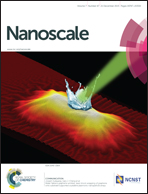Interface engineering: broadband light and low temperature gas detection abilities using a nano-heterojunction device†
Abstract
Herein, we have designed a nano-heterojunction device using interface defects and band bending effects, which can have broadband light detection (from 365–940 nm) and low operating temperature (50 °C) gas detection abilities. The broadband light detection mechanism occurs because of the defects and band bending between the heterojunction interface. We have demonstrated this mechanism using CoSi2/SnO2, CoSi2/TiO2, Ge/SnO2 and Ge/TiO2 nano-heterojunction devices, and all these devices show broadband light detection ability. Furthermore, the nano-heterojunction of the nano-device has a local Joule-heating effect. For gas detection, the results show that the nano-heterojunction device presents a high detection ability. The reset time and sensitivity of the nano-heterojunction device are an order faster and larger than Schottky-contacted devices (previous works), which is due to the local Joule-heating effect between the interface of the nano-heterojunction. Based on the abovementioned idea, we can design diverse nano-devices for widespread use.


 Please wait while we load your content...
Please wait while we load your content...